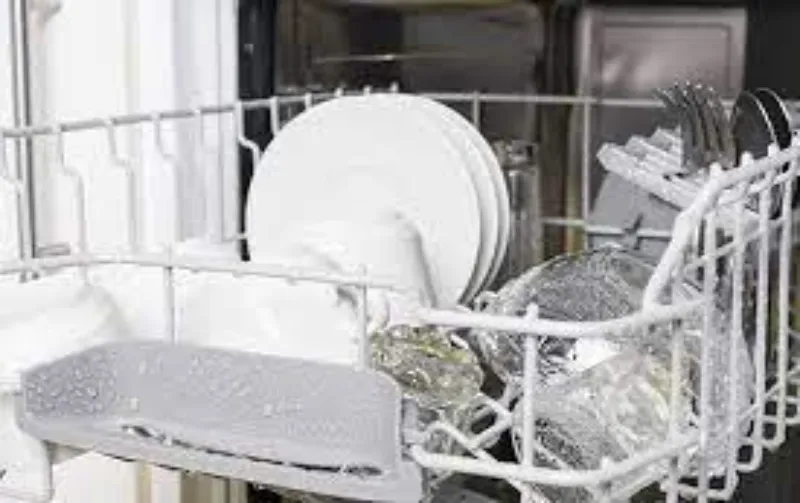Yes, dishwashers are designed to dry dishes after washing them. The drying can vary depending on the model and settings.
Modern dishwashers are not just a convenience; they have become an indispensable part of kitchen efficiency.
They streamline the clean-up process after meals, banishing the days of laborious hand-washing.
But the usefulness of a dishwasher extends beyond just cleaning; it also encompasses drying.
A well-functioning dishwasher will leave your plates, glasses, and utensils not only spotless but also dry, ready to be put away or used again.
This feature saves you time and effort, eliminating the need for towel drying or the risk of water spots.
To ensure your dishes are completely dry, dishwashers use a variety of methods, such as heated air, a fan, or even the heat generated during the wash cycle.
It’s a combination of convenience and hygiene that makes the modern dishwasher an essential kitchen appliance.

The Science Behind Dishwasher Drying
Unloading a dishwasher only to find dishes damp and not ready for the cupboard can be quite frustrating.
But what many might not realize is that dishwasher drying is a process grounded in science, one that combines heat, airflow, and chemical aids to achieve that perfect finish.
The design and settings of your dishwasher play pivotal roles in ensuring that at the end of each cycle, your dishes emerge dry and cabinet-ready.
Let’s delve into the mechanisms behind this everyday appliance miracle so you can understand and optimize your dishwasher’s drying capabilities.
Evaporation Process In Dishwashers
The primary player in the drying phase is the evaporation process.
Post-wash, the dishwasher heats the air inside its chamber, causing water on the dishes to evaporate.
This process is accelerated by the hot walls of the dishwasher’s interior as they provide an excellent surface for condensation and subsequent evaporation.
Enhanced by effective air circulation, the moist air is replaced by drier air, which facilitates the drying process.
Configurations such as stainless steel tubs can retain heat better than plastic ones, promoting faster evaporation and therefore, quicker drying times.
Role Of Rinse Aid And Its Effect On Drying
Aiding in this process is an often overlooked but crucial component — rinse aid.
Rinse aids employ surfactant compounds that reduce the surface tension of water.
The diminished surface tension lets water form a thin layer rather than droplets, which:
- By spreading out, water does not congregate into droplets that can dry and leave water spots.
- A more evenly distributed thin layer of water evaporates more swiftly than droplets.
The rinse aid compartment in your dishwasher provides an easy way to incorporate this agent into every wash, ensuring more consistent drying performance.
Impact Of Water Temperature On Drying Efficiency
Not to be underestimated is the impact of water temperature during the final rinse.
Hot water not only aids in cleaning but also in drying; it evaporates more easily and heats the overall interior environment of the dishwasher.
As hot water cascades over your dishes, it heats them, thus prepping them for efficient drying.
Most modern dishwashers come with a high-temperature final rinse or a sanitary cycle that increases the water temperature, enhancing the evaporative effect. Remember, the key is that:
- Hot water evaporates quickly.
- Warmer dishes dry faster as they prompt water to evaporate upon contact.
Consider checking the temperature setting of your home’s water heater to ensure it falls within the optimal range for your dishwasher’s drying effectiveness.
Factors Affecting Drying Performance
At the heart of the modern kitchen is the dishwasher—a true marvel that saves us time and keeps our dishes sparkling clean.
But does your dishwasher leave your dishes perfectly dry?
Understanding the factors that affect your dishwasher’s drying performance is key to ensuring you won’t be left with a soggy mess.
From how you load the machine to the type of dishes you use, let’s delve into the aspects that play a crucial role in drying efficiency.
Proper Loading Of Dishes For Effective Drying
Positioning is paramount when it comes to getting dishes not just clean but also dry. Here’s how to master the art of loading:
- Ensure dishes are spaced out to allow air and water jets to reach every surface.
- Angle cups, bowls, and containers to prevent water pooling, promoting quick and even drying.
- Position plasticware on the top rack where drying is less intense to prevent warping.
Effect Of Dish Material On Drying
The materials of your dishes greatly influence drying effectiveness.
Metal and ceramic warm up and dry faster than plastic, which tends to hold moisture.
Glassware can dry spotlessly, while non-stick surfaces may retain water droplets.
Being mindful of these characteristics can help you optimize the drying results for each load.
Importance Of Dishwasher Maintenance In Drying
Regular maintenance isn’t just about prolonging the life of your dishwasher—it’s also about peak performance.
Here are some maintenance tips to ensure optimal drying:
- Clean the filters regularly to prevent clogs that can impede drying.
- Check and clear the vents and fans for any blockages.
- Ensure the rinse aid dispenser is filled to assist in water evaporation.
With these points in mind, you’ll see that your dishwasher’s environment and how you manage it can make a significant difference in how well your dishes emerge—not just squeaky clean, but also perfectly dry and ready to use.
Common Challenges And Solutions For Dishwasher Drying
After a dishwasher cycle finishes, open the door expecting clean and dry dishware only to find them damp or even soaking wet can be frustrating.
Understanding the reasons behind this issue is essential for both maintaining your appliance and achieving the desired drying results.
Reasons For Wet Dishes After The Cycle
Why do dishes come out wet from a dishwasher? Several factors may contribute to this problem.
It’s crucial to identify these to tackle the issue effectively.
- Rinse aid might be insufficient or not used.
- Dishes could be overloaded or improperly loaded, restricting airflow and drying.
- The selected wash cycle might not include a drying phase.
- Temperature settings could be too low to facilitate proper drying.
- The dishwasher’s heating element might be malfunctioning.

Troubleshooting Common Drying Issues
Finding a solution begins with troubleshooting.
Here are some tips:
- Check if rinse aid is needed or needs refilling.
- Ensure dish arrangement allows for ample space between items.
- Experiment with different wash cycles that include a dry option.
- Adjust the water temperature setting if possible.
- Inspect the heating element and consult the manual for any specific troubleshooting guides.
Diy Fixes For Improving Drying Results
Some do-it-yourself tips can significantly enhance drying effectiveness.
Try these methods:
| Tip | Action | Effect |
|---|---|---|
| Use Rinse Aid | Add rinse aid to the dispenser. | Improves water sheeting, lessening droplets. |
| Boost Heat | Choose a high-temp cycle or add a drying boost if available. | Accelerates evaporation. |
| Leave Door Ajar | Crack the door slightly after a cycle. | Releases steam and aids drying. |
| Manual Dry | Hand-dry dishes after the cycle. | Ensures immediate dryness. |
Implementing these simple adjustments can make a significant difference in getting dishes from your dishwasher dry and ready to use.
Maximizing Drying Efficiency In Dishwashers
When it comes to the role of dishwashers in the modern kitchen, they’re no longer just about cleaning your plates, glasses, and cutlery; it’s also expected they leave them perfectly dry and ready to use or store away.
Maximizing drying efficiency in dishwashers is key to this whole process.
But how can you ensure your dishwasher is doing its utmost to turn out spotless and bone-dry dishes every time?
Here’s a look at the latest in drying technology, energy-saving features, and how various models stack up against each other.
Advancements In Dishwasher Technology For Drying
Dishwashers have evolved significantly when it comes to drying performance.
Traditional methods relied heavily on heated air, but new technologies are stepping up the game.
Modern dishwashers now boast features like automatic door opening to release steam, built-in fans, and advanced heat exchange mechanisms.
These innovations work collectively to enhance airflow and condensation, thereby improving drying results.
- Some models automatically open the door at the end of a cycle to allow steam to escape and fresh air to circulate, which speeds up the drying process.
- By circulating air, built-in fans help remove moisture from dishes efficiently.
- These capture and reuse heat from the wash cycle to dry dishes, which proves to be an energy-efficient method.
Energy-efficient Drying Options And Their Effectiveness
Energy efficiency is a crucial aspect of any kitchen appliance.
Cutting-edge dishwashers do more than just save water; they also come with drying methods that use less energy.
Eco-friendly features like heat pump drying and zeolite technology not only lessen the environmental impact but also reduce utility bills without sacrificing performance.
- This system recycles heat generated within the dishwasher, providing an energy-efficient solution to traditional heating elements.
- Utilizing zeolites, a type of volcanic mineral, some dishwashers absorb moisture and emit heat, leading to quicker and more energy-efficient drying.
Comparison Of Different Dishwasher Models For Drying Capabilities
Not all dishwashers are created equal when it comes to their drying prowess.
Top-tier models from prestigious brands offer superior drying technologies, while budget-friendly options may stick to traditional methods.
Nonetheless, determining the right choice depends on specific needs and preferences.
| Brand & Model | Drying Technology | Energy Efficiency |
|---|---|---|
| Brand A – Model X | Heat Pump | High |
| Brand B – Model Y | Auto-Open Door & Fan | Medium |
| Brand C – Model Z | Traditional Heated Dry | Low |
Comparing models based on their drying features is crucial for making an informed decision.
It is worth noting that while high-end appliances may offer cutting-edge drying capabilities, various economical options have incorporated efficient drying technologies, balancing performance and cost.
Frequently Asked Questions On Are Dishwashers Supposed To Dry Dishes
Do Dishwashers Fully Dry Dishes?
Dishwashers are designed to dry dishes effectively but the results can vary depending on the model, the dishwasher’s dry setting, and type of items washed.
Why Are My Dishes Still Wet?
Dishes may remain wet due to overloading, selecting low heat or eco-friendly drying options, improper loading, or a malfunctioning heating element.
Which Dishwasher Drying Method Works Best?
Heated drying typically performs best, using hot air to evaporate moisture, while some dishwashers use fan-assisted or heat pump technology for energy efficiency.
Is Rinse Aid Necessary For Drying?
Using rinse aid can significantly improve drying by reducing water surface tension, preventing water spots, and promoting faster drying, especially on glassware.
Conclusion
To wrap things up, dishwashers are designed to both clean and dry your dishes.
While expectations can vary, modern units come with features that enhance the drying process.
Ensure you select a model that fits your needs and follow maintenance tips for optimal performance.
Embrace the convenience of a dishwasher that leaves your crockery spotless and ready to use.
